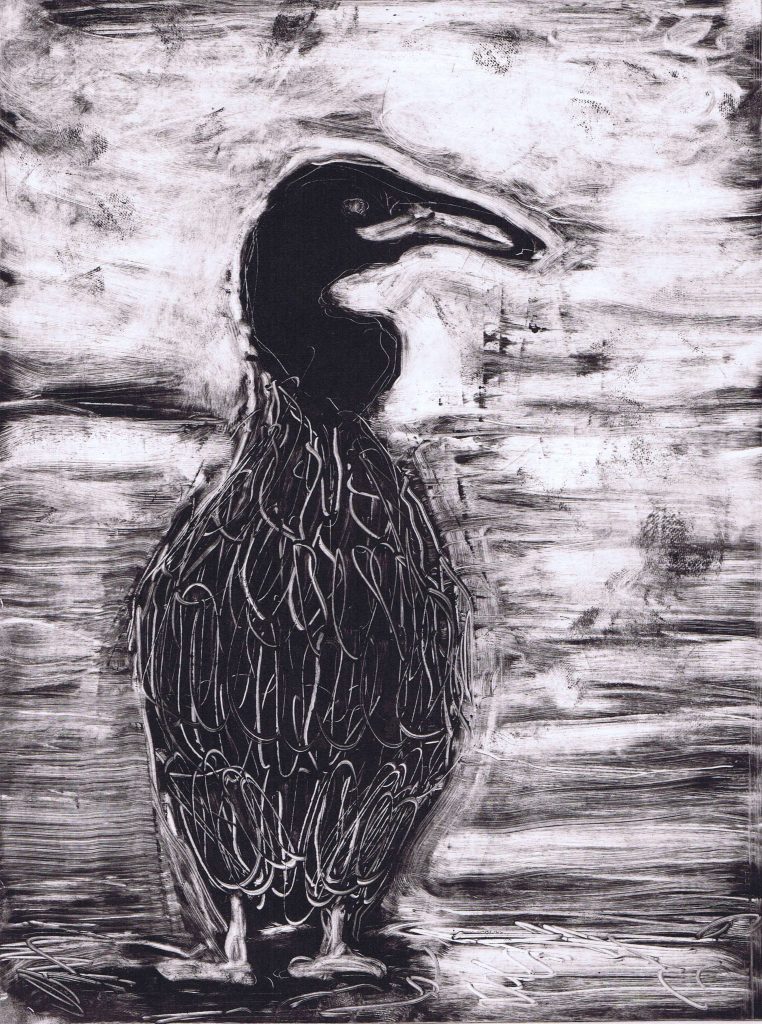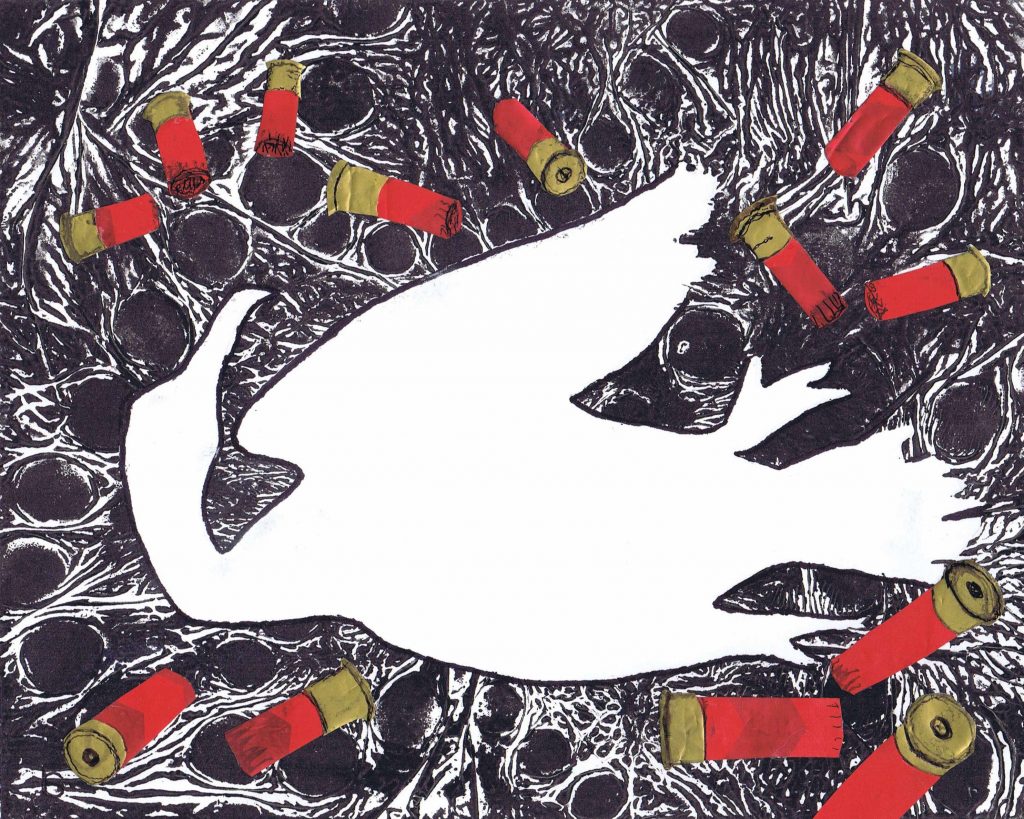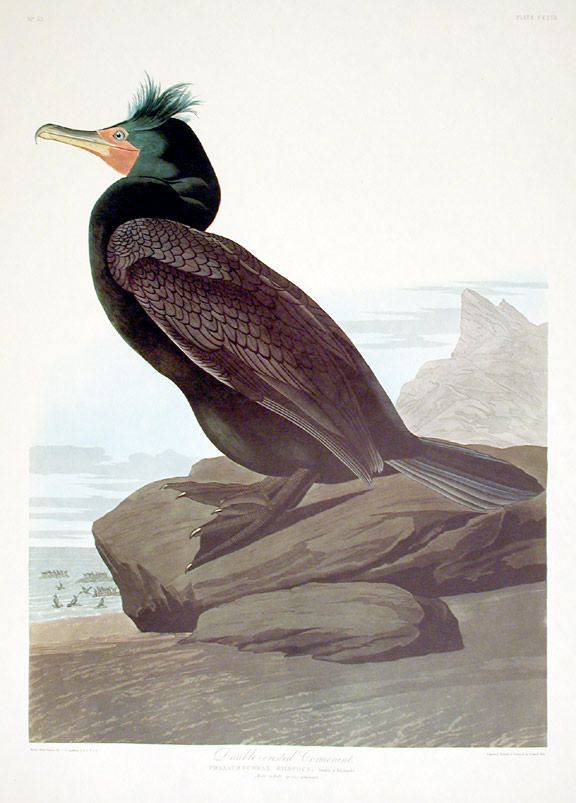Regressive hunting legislation and barbaric population management practices put cormorants in the cross-hairs

In June 2021 while kayaking along the eastern shore of the Ottawa River, I stopped to watch the elegant beauty of a flock of double-crested cormorants flying effortlessly above the river along the shoreline. Just a month later on July 31, 2020, the Ontario Ministry of Natural Resources and Forestry announced a province-wide fall hunting season for cormorants from September 15th to December 31st with a daily bag limit is 15 birds under the authority of a small game licence. (1) I wondered why anyone would want to hunt cormorants which are not considered game animals.
I have created two prints to draw attention to the plight of the double-crested cormorant in Ontario in light of the new legislation. Cormorant 1/1 (2022) is a monotype of a bird with its back to the viewer looking out along the shoreline. Dead Cormorant 1/1 (2022) is a monotype with ink and collaged plastic. Using a stencil, the blank space signifies the absence of the dead cormorant surrounded by shotgun shells – the evidence of the carnage.

They pieces are on display until October 23, 2022 as part of the Painterly Printmaking exhibition at the Connective Gallery at the Nepean Creative Arts Centre.
From a protected species to a target of wanton hunting
The population of cormorants has been growing in Ontario for decades and so has a call for management by property owners and the Ontario Federation for Hunters and Anglers (OFAH) (1). Cormorants are colony nesters and the sites of colonies can be alarming since their acidic waste and ungainly nests cause some die-back of trees at the water’s edge where they make their nests. Once near extinction before the ban of DDT and protected under the Fish and Wildlife Conservation Act of 1997, the Fish and Wildlife Conservation Amendment Act (Double-Crested Cormorants) was enacted in 2016 to permit the hunting and trapping of double-crested cormorants (2). Since then many environmental and animal advocacy voices have spoken up in protest on grounds that the population of this native species is not excessive and still in rebound from near-extinction; that the claim of decimating sport fish populations is false, and that in areas where the population is heaviest, alternative more humane ways of management could be used (3). Legal experts also advise that precedents set in the legislation — allowing shooting from boats and leaving dead carcasses — present dangers for both wildlife and humans in the affected areas (4).
A reminder of the larger cultural context of “pristine nature”
With the continued loss of habitat, it is no wonder that humans and cormorants are coming into conflict and rather than letting nature take its course, humans want to manage nature. This has been particularly poignant at Pelee Island National Park where Parks Canada has been undertaking culls of cormorants on Middle Island from 2008 to 2021 to preserve a Carolinian forest ecosystem (5 & 6). The culling occurs in the spring during breeding season with sharp-shooters aiming at the nesting cormorants reluctant to leave their eggs and chicks (7). See the video showing the inhuman methods of population management within what is supposed to be a bird sanctuary.
The debate is ongoing whether population management is indeed needed. If it is, can’t people charged on our behalf with protecting the environment find less regressive and violent ways than shooting and maiming birds on the nest? How we are treating double-crested cormorants calls to mind how colonizers treated indigenous peoples when governments first decided to set aside portions of “pristine nature” in perpetuity as conservation areas and parks.
I am ending this post with an image of the double-crested cormorant from John James Audubon’s Birds of America, printed between 1827 and 1838. Although beautiful, these works are tainted with past and present cultural concerns about racism and exclusion in conservation movements (8).

References:
(1) https://www.ofah.org/issues/cormorants/.
(2) Bill 205, Fish and Wildlife Conservation Amendment Act (Double-Crested Cormorants), 2016, https://www.ola.org/en/legislative-business/bills/parliament-41/session-1/bill-205.
(3) For examples, Ontario Nature https://ontarionature.org/ontarios-cormorants-blog/, https://www.animalalliance.ca/new-cormorant-video-exposes-cruelty/; Nature Canada, https://ottawacitizen.com/opinion/cheskey-ontarios-cormorant-hunt-is-based-on-pandering-rather-than-science; Animal Alliance of Canada, https://www.animalalliance.ca/campaigns/other-campaigns/double-crested-cormorant-slaughter/.
(4) https://ontarionature.org/cormorant-legal-blog/
(5) https://www.cbc.ca/news/canada/windsor/cull-parks-canada-point-pelee-1.6001841
(6) https://www.cbc.ca/news/canada/windsor/cormorant-culls-stabilizing-middle-island-parks-canada-says-1.3753614.
(7) https://www.animalalliance.ca/new-cormorant-video-exposes-cruelty/.
(8) https://www.audubon.org/birds-of-america.
